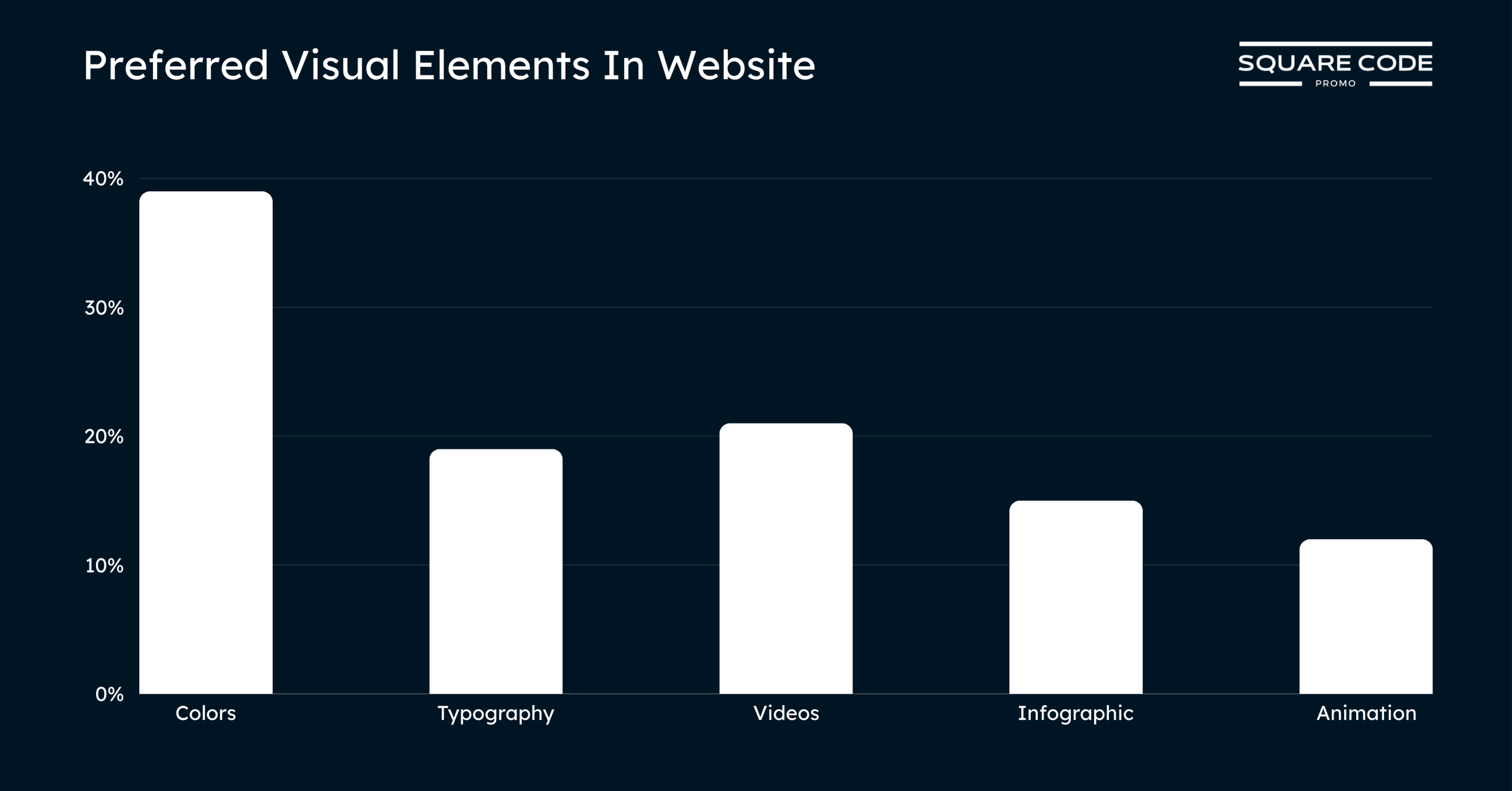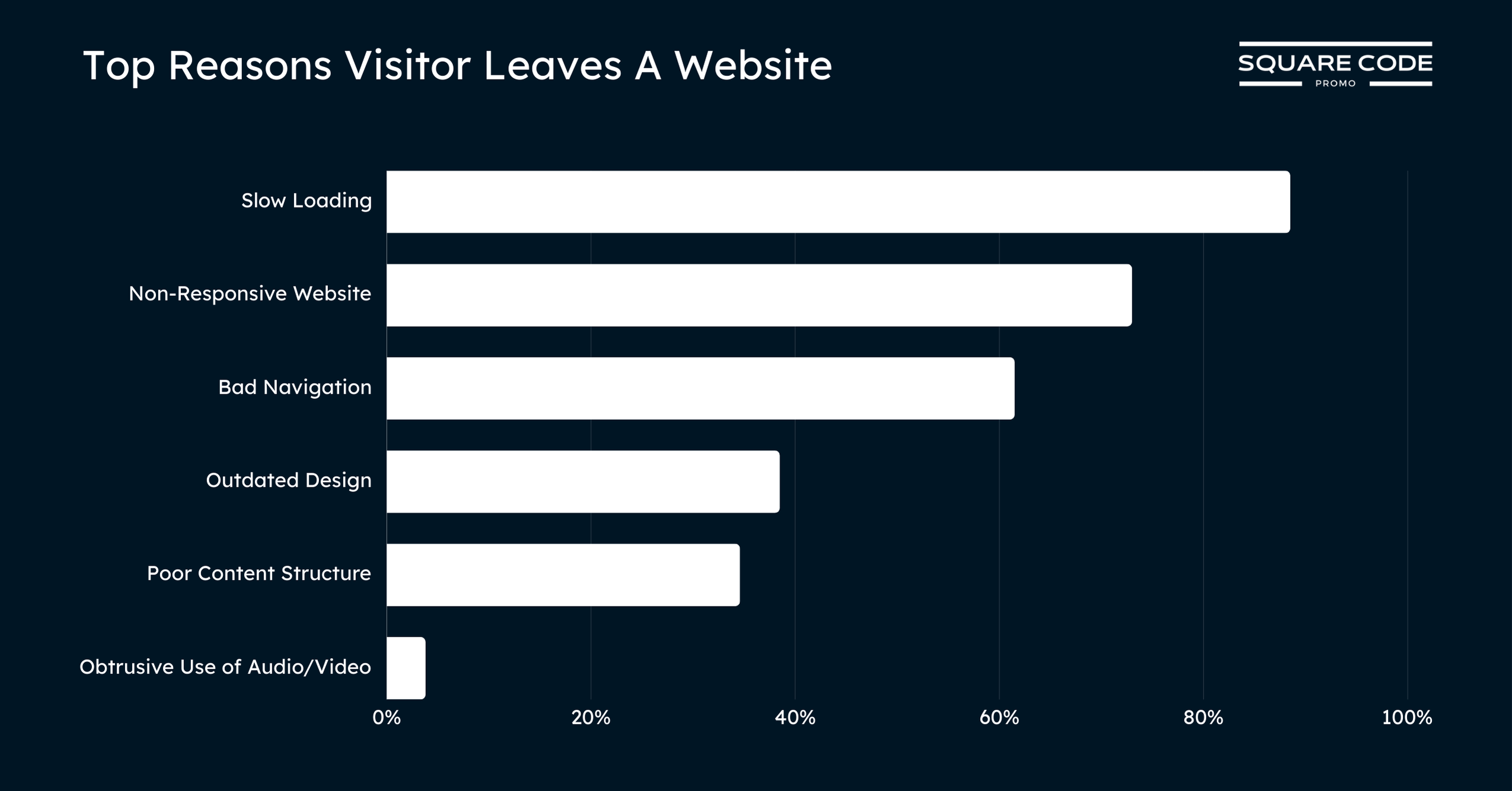A website serves as the first point of contact between a company and its potential customers. A well-designed website conveys professionalism and builds trust and confidence.
Elements such as ease of navigation, mobile responsiveness, clean layout, and overall aesthetic appeal contribute significantly to how visitors perceive the brand.
Conversely, poorly designed websites can have a negative impact, leading to a loss of 39% of customers. Outdated visuals, broken links, or a lack of user-friendliness can turn visitors away, leaving them with a poor impression of the company.
In this article, I have covered the latest facts and figures about the impact of web design on visitors, the importance of eye-catching designs, and additional insights in this article.
Web Design Statistics 2024 (In A View)
- 1.1 billion websites are there globally.
- 50% of businesses form an impression of a business through their web design.
- 40% of users will leave a website if it takes more than 3 seconds to load.
- More than 70% of businesses invest in design to differentiate themselves from their competitors.
- Spending on UX yields a ROI of ROI of 9,900%.
How Many Websites Are There In 2024?
1. There are approximately 1.1 billion websites globally as of 2024
However, only about 193.89 million, or 17%, of these websites are active, while 83% are inactive. Additionally, around 252,000 new websites are being created daily, which equals to:
- 10,500 new websites are created every hour
- 175 new websites are created every minute
- 3 new websites are created every second
Source: Stieefy
How Big Is The Web Design Market In 2024?
2. The global web design market size is $556.82 billion as of 2024.
The market is estimated to grow at a CAGR of 8.50% between 2024 and 2031, reaching $985.65 billion by the end of 2031.
Meanwhile, North America is the biggest web design region market, valued at $22.73 million in 2024. The market is estimated to grow at a CAGR of 6.7% in the forecast period.
At the same time, the web design market in the United States is valued at $17.93 billion. The market is estimated to grow at a CAGR of 6.5% between 2024 and 2031, reaching $27.86 billion by 2031.
Source: Cognitive Market Research
General Website Design Statistics
3. About 75% of people base their opinion of a company’s credibility on the quality of its website design.
Website design is not merely about appearance; it’s about providing a smooth experience that builds trust and credibility. How a site looks, how well it works, and how easy it is to use all play a big role in shaping how people view a business.
Source: Stanford University
4. 38% of people will leave a website if they find its layout unattractive.
An unattractive or disorganized layout can quickly drive users away, causing them to leave the site for one that is more visually appealing. Ensuring a clean, user-friendly design is crucial for keeping visitors engaged and encouraging them to explore more of the website’s content.
Source: Adobe
5. Every $1 spent on the UX yields a return of $100.
This results in an impressive ROI of 9,900%, demonstrating the significant impact that effective UX design can have on a company’s profitability.
Hence, prioritizing UX in business strategies is important to drive financial success and enhance customer satisfaction.
Source: UX Planet
6. A good user interface can increase your website’s conversion rate by up to 200%.
Additionally, focusing on enhancing the overall user experience (UX) can lead to an even greater boost, with conversion rates potentially increasing by as much as 400%. This highlights the importance of investing in both UI and UX to improve customer interaction and drive business growth.
Source: UX Planet
7. 42% of users will abandon a website due to poor functionality.
When users face problems like slow loading times or broken links, they tend to look for other options, resulting in missed opportunities for businesses. By focusing on functional design, companies can greatly enhance user retention and overall satisfaction.
Source: Hubspot.
8. 2 out of 5 visitors prefer images as a visual element on company websites.
By focusing on high-quality images, businesses can better capture visitors’ attention and create a more appealing online presence.
Additionally, 39% of visitors expressed a desire for more colors on these sites, while 15% indicated a preference for infographics.

The following table displays the preferred visual elements that visitors would like to see on company websites:
- Images: 40%
- Colors: 39%
- Typography: 19%
- Videos: 21%
- Infographic: 15%
- Animation: 12%
Source: Hubspot.
Website Design Impact On User Experience
9. 94% of visitors will abandon a website due to unattractive or poor graphic design.
First impressions matter in today’s digital landscape, and poor graphic design can quickly deter potential customers. This highlights the importance of businesses investing in high-quality, captivating visuals that keep users interested and encourage them to return.
Source: Manage Business
10. Users form an impression of a website in just 50 milliseconds or 0.05 seconds.
This split-second judgment can significantly influence whether they stay or leave the site.
Key elements like the layout, font choices, color palette, and overall design structure all contribute to this initial impression. Despite the brief time frame, these factors combine to create either a positive or negative impact, directly influencing how users perceive the brand or business.
Source: CXL
11. On average, it takes users approximately 2.6 seconds to focus on key sections of a website that are most likely to shape their first impression.
These areas typically include elements like the menu, logo, images, and social media icons, which capture attention before users shift their focus to other parts of the page. The better the first impression, the longer the participants stayed on the page.
A positive first impression encourages visitors to stay on the page longer, increasing their chances of interacting with the content and making the initial impression crucial for user engagement.
Source: Missouri University of Science and Technology
12. A striking 94% of first impressions are directly influenced by a website’s design.
A British analyst’s research emphasized that the visual appeal of a website is a key factor in forming that initial impression. On the flip side, a poorly designed website can result in negative judgments within seconds, potentially causing a loss of customers.
Source: ACM digital library.
Website Design Responsiveness Statistics
13. Approximately 90% of the websites have a responsive design.
That accounts for around 1.71 billion websites on the internet.
This move towards responsive design indicates that businesses are becoming increasingly aware of the need to deliver a seamless user experience on all devices. By making their websites adaptable to different screen sizes, companies can more effectively engage users and satisfy the expectations of today’s mobile-focused audience.
Source: DiviFlash
14. 73.1% of web designers say that a non-responsive design is the main reason visitors leave a website.
Three-fourths of web designers believe that a non-responsive design is the second most common reason visitors leave a website.
Meanwhile, 88.5% of web designers report that slow loading speeds remain the top reason visitors leave a website.

Here is a table displaying the top reasons web designers believe a visitor is leaving a website:
| Reason | Percentage Of Web-designers |
|---|---|
| Slow Loading | 88.5% |
| Non-Responsive Website | 73% |
| Bad Navigation | 61.5% |
| Outdated Design | 38.5% |
| Poor Content Structure | 34.6% |
| Obtrusive Use of Audio/Video | 3.8% |
Source: Hubspot
15. 53.8% of website designers identify the lack of a responsive design for all screen sizes as a key factor driving the need for a website redesign.
According to research, over half of website designers point to the lack of a responsive design that accommodates all screen sizes as a significant reason for pursuing a website redesign. By ensuring that websites work smoothly on different devices, businesses can enhance user satisfaction and engagement, resulting in a more successful online presence.
Source: Hostinger
Mobile Web Design Statistics
16. 61.72% of the traffic worldwide comes from mobile devices.
This higher share of traffic from mobile devices highlights the necessity for businesses to prioritize mobile optimization to engage their audience and enhance user experience effectively.
Source: StatCounter
17. Nearly Three-fourths (74%) of users are more likely to revisit a website if it is optimized for mobile devices.
Moreover, 79% of users are more likely to revisit and share a mobile site if it provides a simple and user-friendly experience. This emphasizes the critical role of mobile optimization and user-friendly design in attracting and retaining visitors, as well as encouraging word-of-mouth referrals.
Source: Think With Google1, Think With Google
Website Speed Statistics
18. Nearly half (43%) of small business owners intend to enhance their website’s performance and page loading speed.
Websites that load quickly provide a smoother browsing experience, which leads to higher user satisfaction and increased engagement. More and more businesses are recognizing that both speed and good design are crucial for keeping visitors on their sites, encouraging interaction, and driving overall growth and success online.
Source: Forbes
19. 39% of the visitors to a website lose interest due to slow image loading.
Slow image loading can greatly impact user engagement, making it essential to optimize loading speeds keep visitors interested and prevent them from leaving the site. By focusing on faster load times, businesses can improve the user experience and boost the chances of retaining visitors.
Source: Hostinger
Adoption Of AI In Web Design
20. 35.9% of Web Designers Use AI Tools.
Interestingly, 55% of designers indicate that both companies and clients support their decision to incorporate AI into website design. However, 12% have no established policy regarding AI usage in web design, while 10% feel discouraged from integrating it into their workflow.
Source: Hostinger
21. 58% of web designers use AI to generate images and other media.
Artificial Intelligence (AI) is changing the web design field, with 51% of designers using it to build web pages, significantly increasing productivity. In the design planning stage, 49% of designers use AI to discover new strategies and elements.
Additionally, 43% use AI to improve and enhance their designs. Moreover, 40% of web designers rely on AI for tracking performance and quality, while 20% use it to assess user experience.
Source: Hostinger.
Conclusion: A Good Web Design Is Likely To Increase Conversion By 200%
good web design is intuitive, responsive, and visually attractive, facilitating smooth navigation and engagement across devices. It successfully conveys the brand’s message while being optimized for speed, accessibility, and search engine performance.
As a result, a well-optimized website can achieve a conversion rate that is three times higher.
Moreover, investing in quality user experience (UX) can yield businesses a return of 9,900% and a five times higher conversion rate than other websites.
